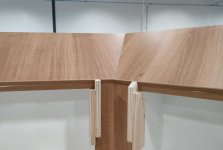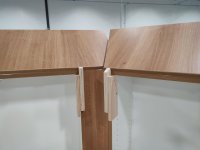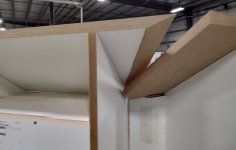- Joined
- Oct 16, 2015
- Messages
- 5,559
These are quite common in hospitals and their satellite offices. They put them in places where there are no soffits. As I understand it, for a few reasons. They don't collect dust and are far easier to clean. They also prevent people from storing or hiding things up there. In new construction, the angled supports are built into the sides of the cabinets and the top is a loose piece that is installed after the cabinets are on the wall. Once in a while they are built as a free-standing unit that can be retrofitted to standard flattop cabinets. For normal straight runs, these are taken care of by the countertop department. When they wrap around a corner, they come to me. Mitering something like this is not particularly effective, since the odds of the walls actually being square are astronomical. "Adjusting" a miter seam on something like this, which is 18" wide, in the field? I wouldn't want to, so the solution that I came up with many years ago, is coping. This is a bit of a challenge itself, but it can compensate for a slight out-of-square condition (either way) fairly easily.
The biggest challenge is the angle on the back of the overlying piece. The lower the angle of the slope, the more exaggerated this becomes. I have done dozens, if not into the hundreds, over the years, all of them around 90 degree corners. Yesterday had three firsts on the same unit. I have never done one with a 3mm PVC edge, one on a 45 degree corner, or made from MDF. This one had all them all. Usually, I can cut the main miter angle and bevel the back side "mostly" with the TS55 and the maximum 45 degree angle is enough, or close to enough. The little hook on the front goes the opposite direction, so the cut can't be completed this way though, it takes some hand work at that point. This one was way over that though. The pencil line that you can see on the back of the upper piece is 2" from the long point of the bevel. I do that totally by hand with the RAS115, "carving it to a line. The dust from the MDF was quite a mess. It is very hard for the CT to catch this because of the angle. The contact with the material is so minimal, that the sanding pad or brush cannot trap/steer the dust to the collection port. Years ago, I did this part with that tiny Porter-Cable belt sander. It worked, I really liked that tool, but the RAS115 does it better.
I've done a few outside corners too, but you are stuck with mitering there.
Sorry for the long winded explanation, but this is something that a huge percentage of people have never seen and will likely never have to replicate, but I thought it would be interesting. Maybe inspire some thought outside the box?
The biggest challenge is the angle on the back of the overlying piece. The lower the angle of the slope, the more exaggerated this becomes. I have done dozens, if not into the hundreds, over the years, all of them around 90 degree corners. Yesterday had three firsts on the same unit. I have never done one with a 3mm PVC edge, one on a 45 degree corner, or made from MDF. This one had all them all. Usually, I can cut the main miter angle and bevel the back side "mostly" with the TS55 and the maximum 45 degree angle is enough, or close to enough. The little hook on the front goes the opposite direction, so the cut can't be completed this way though, it takes some hand work at that point. This one was way over that though. The pencil line that you can see on the back of the upper piece is 2" from the long point of the bevel. I do that totally by hand with the RAS115, "carving it to a line. The dust from the MDF was quite a mess. It is very hard for the CT to catch this because of the angle. The contact with the material is so minimal, that the sanding pad or brush cannot trap/steer the dust to the collection port. Years ago, I did this part with that tiny Porter-Cable belt sander. It worked, I really liked that tool, but the RAS115 does it better.
I've done a few outside corners too, but you are stuck with mitering there.
Sorry for the long winded explanation, but this is something that a huge percentage of people have never seen and will likely never have to replicate, but I thought it would be interesting. Maybe inspire some thought outside the box?



